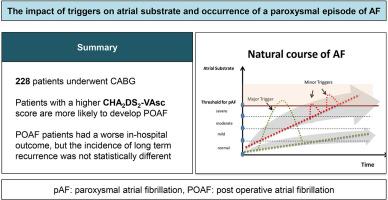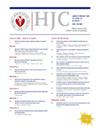心房颤动术后与心律失常复发风险:阿佛洛狄特研究。
IF 3
3区 医学
Q2 CARDIAC & CARDIOVASCULAR SYSTEMS
引用次数: 0
摘要
背景:冠状动脉搭桥术(CABG)术后新发心房颤动(POAF)的发生率为 20%-40%。目的:AFRODITE 研究是一项前瞻性多中心队列研究,其主要终点是评估 CABG 术后患者一年内房颤复发的情况:研究共纳入 228 名年龄大于 50 岁、接受过孤立的心血管手术的患者。将患者分为 POAF 和非 POAF 两组,随访 12 个月,以了解房颤复发、住院和死亡情况:研究共纳入 228 名患者(平均年龄 67 岁,88.6% 为男性)。28.5%的患者在指数住院期间至少发生过一次 POAF(POAF 组),并与非 POAF 组(163 人)进行了比较。多变量逐步逻辑回归分析表明,POAF 的最强预后参数是 CHA2DS2-Vasc 评分(赔率=1.61,p 结论:有趣的是,对研究中的患者进行为期一年的前瞻性随访并未发现 POAF 患者和非 POAF 患者之间存在显著差异。一个值得注意的发现是,CHA2DS2-Vasc评分较高的患者更有可能发展为POAF。本文章由计算机程序翻译,如有差异,请以英文原文为准。

Atrial fibrillation post CABG and the risk of arrhythmia recurrence: the AFRODITE study
Background
New-onset postoperative atrial fibrillation (POAF) after coronary artery bypass surgery (CABG) occurs with an incidence of 20–40%. The clinical relevance of POAF remains a concern, and the need for further studies regarding the clinical management of POAF is necessary.
Aim
The AFRODITE study, a prospective multicenter cohort study, had as its primary endpoint the evaluation of AF recurrence in patients post CABG over a one-year period.
Methods
Two hundred twenty-eight patients aged >50 years who underwent isolated CABG were included in the study. Patients were stratified into two groups, POAF and non-POAF, and followed for 12 months for AF recurrence, hospitalizations, and death.
Results
Two hundred twenty-eight patients (mean age 67 years, 88.6% male) were included in the study. 28.5% of patients experienced at least one episode of POAF during index hospitalization (POAF group) and were compared with the non-POAF group (n = 163). Multivariate stepwise logistic regression analysis showed that the strongest prognostic parameter for POAF was the CHA2DS2-VASc score (odds ratio = 1.61, p < 0.001). POAF patients had a worse in-hospital outcome, but the incidence of long-term AF recurrence was not statistically different (3.6% vs. 4.8%, p = 0.9).
Conclusion
Interestingly, a one-year prospective follow-up of patients in the study did not reveal significant differences between POAF and non-POAF patients. A notable finding was that patients with a higher CHA2DS2-VASc score were more likely to develop POAF.
求助全文
通过发布文献求助,成功后即可免费获取论文全文。
去求助
来源期刊

Hellenic Journal of Cardiology
CARDIAC & CARDIOVASCULAR SYSTEMS-
CiteScore
4.90
自引率
7.30%
发文量
86
审稿时长
56 days
期刊介绍:
The Hellenic Journal of Cardiology (International Edition, ISSN 1109-9666) is the official journal of the Hellenic Society of Cardiology and aims to publish high-quality articles on all aspects of cardiovascular medicine. A primary goal is to publish in each issue a number of original articles related to clinical and basic research. Many of these will be accompanied by invited editorial comments.
Hot topics, such as molecular cardiology, and innovative cardiac imaging and electrophysiological mapping techniques, will appear frequently in the journal in the form of invited expert articles or special reports. The Editorial Committee also attaches great importance to subjects related to continuing medical education, the implementation of guidelines and cost effectiveness in cardiology.
 求助内容:
求助内容: 应助结果提醒方式:
应助结果提醒方式:


